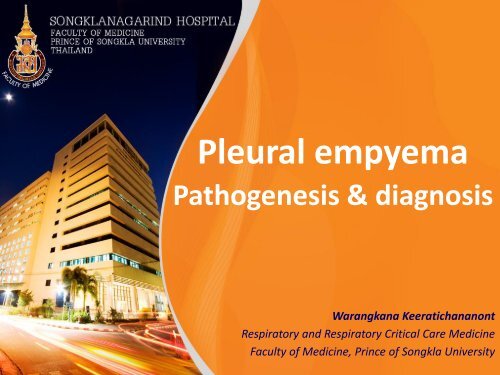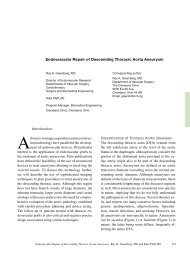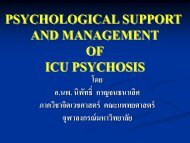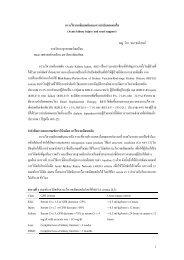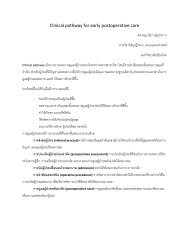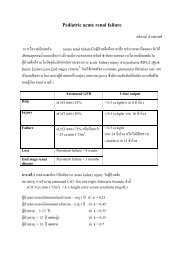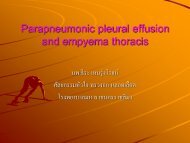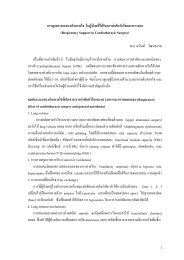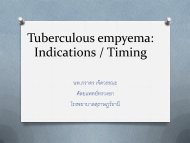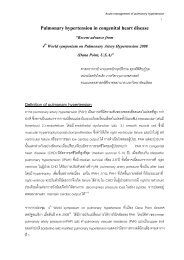Pathogenesis : empyema phases
Pathogenesis : empyema phases
Pathogenesis : empyema phases
You also want an ePaper? Increase the reach of your titles
YUMPU automatically turns print PDFs into web optimized ePapers that Google loves.
Parapneumonic pleural effusions• Uncomplicated parapneumonic effusion• Complicated parapneumonic effusion• Thoracic <strong>empyema</strong>.
<strong>Pathogenesis</strong> : <strong>empyema</strong> <strong>phases</strong>
<strong>Pathogenesis</strong> : <strong>empyema</strong> <strong>phases</strong>• Exudative phase:clear, straw-colored effusion(pH>7.3, glucose 60 mg%, LDH < 500 U/L )• Fibrinopurulent phase:effusion contains large numbers of bacteria and WBC,deposition of fibrin on both the visceral and parietal pleura( pH < 7.2 , glucose < 40mg%, LDH > 1000 U/L)• Organizing <strong>empyema</strong> phase : an <strong>empyema</strong> capsule containspus.Clinics Chest Med 2010;20:607-622
Etiology• Para-pneumonic 60-70 %- pneumonia- lung abscess- infected bronchiectasis• Post thoracic surgery 20 %- lung resection- esophagectomy- mediastinal surgery• Post traumatic 5-10 %Chapman SJ, Davies RJ Respirology. 2009;9:4-11.
Empyema :pathogens‣ Pneumococus‣ Streptococus‣ Staphylococus‣ Haemophilus influenzae‣ Gram-negative bacteria (pseudomonas, klebsiella,enterobacteriace)‣ Anaerobic bacteria‣ Mixed bacterial flora‣ Tuberculosis‣ ActinomycosisHeffner JE. Clinics Chest Med 1999;20:607-622
Empyema : Diagnosis• History & Physical exam• Pleural fluid analysis• ImagingClinics Chest Med 2010;20:607-622
Clinical manifestations• Aerobic bacterial pneumonia– An acute febrile illness with chest pain, sputumproduction, and leukocytosis.– Sepsis/ septic shock– Poor prognosisClinics Chest Med 2010;20:607-622
Clinical manifestations• Anaerobic bacterial infection– Usually presents with subacute illness.– symptoms persisting for more than 7 days.– 60% of patients have weight loss.– Poor oral hygiene– Factors predisposing to recurrent aspiration.Clinics Chest Med 2010;20:607-622
Clinical manifestations• Tuberculosis & fungus– Chronic onset, illness.– Symptoms persisting for several months.– Usually loculations/septation– Necessitans is commonClinics Chest Med 2010;20:607-622
Diagnostic imaging chest X-ray pleural ultrasonography computed tomography diagnostic videothoracoscopy diagnostic thoracotomyClinics Chest Med 2010;20:607-622
Chest x-rays• PA and lateral decubitus• Adult studies sensitivity 67% and specificity 70%• PA at least 400 ml fluid vs. 50 ml lateral decubitus• Assess for loculationsHeffner JE. Clinics Chest Med 2012;20:7-22
Ultrasound• Classification– Stage 1: anechoic fluid– Stage 2: loculations– Stage 3: solid peel• Guide placement of intercostal drainHogan MJ, Cooley BD. Paediatric Resp Reviews 2008;9:77-84
Ultrasound• Size of effusion• Differentiate consolidation from <strong>empyema</strong>• Unreliable predictor of disease severity
Rediology. 2010;10:12-35.
Rediology. 2010;10:12-35.
Rediology. 2010;10:12-35.
CT scan• Anatomical– Parenchymal lesions– Endobronchial lesions– Mediastinal lesions– Lung abscess
Rediology. 2010;10:12-35.
Rediology. 2010;10:12-35.
Rediology. 2010;10:12-35.
Rediology. 2010;10:12-35.
Pleural <strong>empyema</strong> - Videothoracoscopy
“ ขอให้ถือประโยชน์ส่วนตน เป็ นกิจที่สองประโยชน์ของเพื่อนมนุษย์ เป็ นกิจที่หนึ่งลาภ ทรัพย์ และเกียรติยศ จะตกแก่ท่านเองถ้าท่านทรงธรรมะแห่งอาชีพ ไว้ให้บริสุทธิ ์ ”พระบรมราชปณิธานของสมเด็จพระบรมราชชนก


